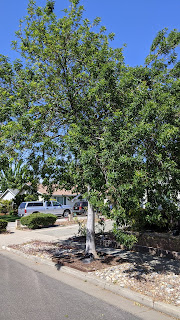Ornamental pear - Pyrus calleryana
The ornamental pear is also known as a Callery pear or Bradford pear. Unlike a regular pear tree, which bears large edible fruit, the callery pear has very small woody fruit that are eaten by birds. The small fruit make it easy for cities to plant as public trees. This hybrid plant was developed in the 1950's as a solution to "fire blight", and given official status by the Department of Agriculture in 1964.
Ornamental pear trees grow to 25' tall. They are resistant to disease, but they’re vulnerable storm damage due to their rapid growth rate. About fifteen years ago two ornamental pear trees on Nightingale Ave fell over after a strong winter storm. A few months later a third callery pear on the same street was removed by the city because the trunk was beginning to rot.
Because of their structural weakness, Callery pears have been legally banned from sale in Ohio. In Oct 2021 they will also be banned from sale in South Carolina. This article from the Greenville (SC) Post and Courier explains the history of the Callery pear and the subsequent inclusion on the South Carolina State Plant Pest List. Nurseryman Durant Ashmore also wrote a blog post The Curse of the Bradford Pear pleading with people not to plant them.

Where to find them: Ornamental pears are very common in Sunnyvale. Some big spots are the south end of Morse Ave, N. Eden Ave, Madrone Ave and W. California Ave between Pajaro and N. Pastoria.




Comments
Post a Comment